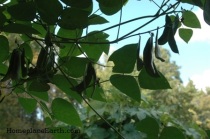Malabar spinach is the plant to grow to fit the niche for “summer greens” in your garden. I grow kale and collards through the winter for greens to harvest fresh for our dinner table from fall to spring, but they don’t do well in hot weather. Neither does regular spinach, which likes the same cool temperatures as kale and collards. Despite its name, Malabar spinach (Basella alba or Basella rubra) is not related to regular spinach (Spinacia oleracea).
I first saw Malabar spinach growing in my daughter’s garden. She only had a few plants and they were crawling prolifically along the top of a fence that supported other crops. It was abundant, provided a cooking green for summer meals, and was colorful with its glossy green leaves and red stems. Last year when I put up the trellises over my paths I thought that was just the thing to try there. (You can read about those trellises I made from livestock panels at https://homeplaceearth.wordpress.com/2013/10/08/trellis-your-garden-paths/. )
When ordering seeds in early 2013, I saw Malabar spinach offered in a seed catalog and ordered it. What I didn’t know is that there are two types of Malabar spinach. What I bought was green Malabar (Basella alba). What I was anticipating was red Malabar (Basella rubra). My 2013 crop of Malabar spinach had thick green stems and didn’t climb well. In fact, it was slow to grow at the beginning of the summer. Later in the summer it was abundant, but it never grew as tall as the red variety. I’ve had the pleasure of taking a sneak peek at David Kennedy’s upcoming book Eat Your Greens: the surprising power of homegrown leaf crops, published by New Society and due to be in the bookstores about October 1. Kennedy, who refers to this crop as vine spinach, says the red variety produces best in early to mid summer and the green variety produces best in late summer to fall. Both varieties will succumb to frost. That explains why not much was happening with my Malabar spinach early in the summer last year when I was anxious to have it take off up the trellis.
This year I am growing the red variety of Malabar spinach and am pleased with it. I planted the seed at the base of both sides of my trellis, but something happened to keep it from growing on one side. Many things this summer have kept me distracted and failing to replant when necessary, so that side never got replanted. The side that it is growing on looks great! I can pick the leaves from a standing position as I walk through my garden, harvesting this and that for dinner. Those red stems are edible, also. The path between two sections in my garden is behind the climbing spinach you see in the photo. As you can see, it climbs the trellis well, providing shade to the path, and is colorful. I just have to smile when I see it. If I would have given this crop any attention at all, other than putting the seeds in the ground one time, I would have had Malabar spinach coming up over the top of the trellis from the other side.
My friend Brent tells me that it reseeds readily, so to expect volunteers to pop up next year. In his book, David Kennedy says the red variety will do that, but the green variety often flowers too late to produce viable seed before frost. Malabar spinach is an easy-to-care-for crop in my garden. The only attention I have given it is to redirect the vines to the trellis when they stray into the path. This crop doesn’t have the tendrils to reach out and grab the trellis that squash plants have.
If you want to add a tasty addition to your garden that thrives in hot weather, I encourage you to plant Malabar spinach.![]()













